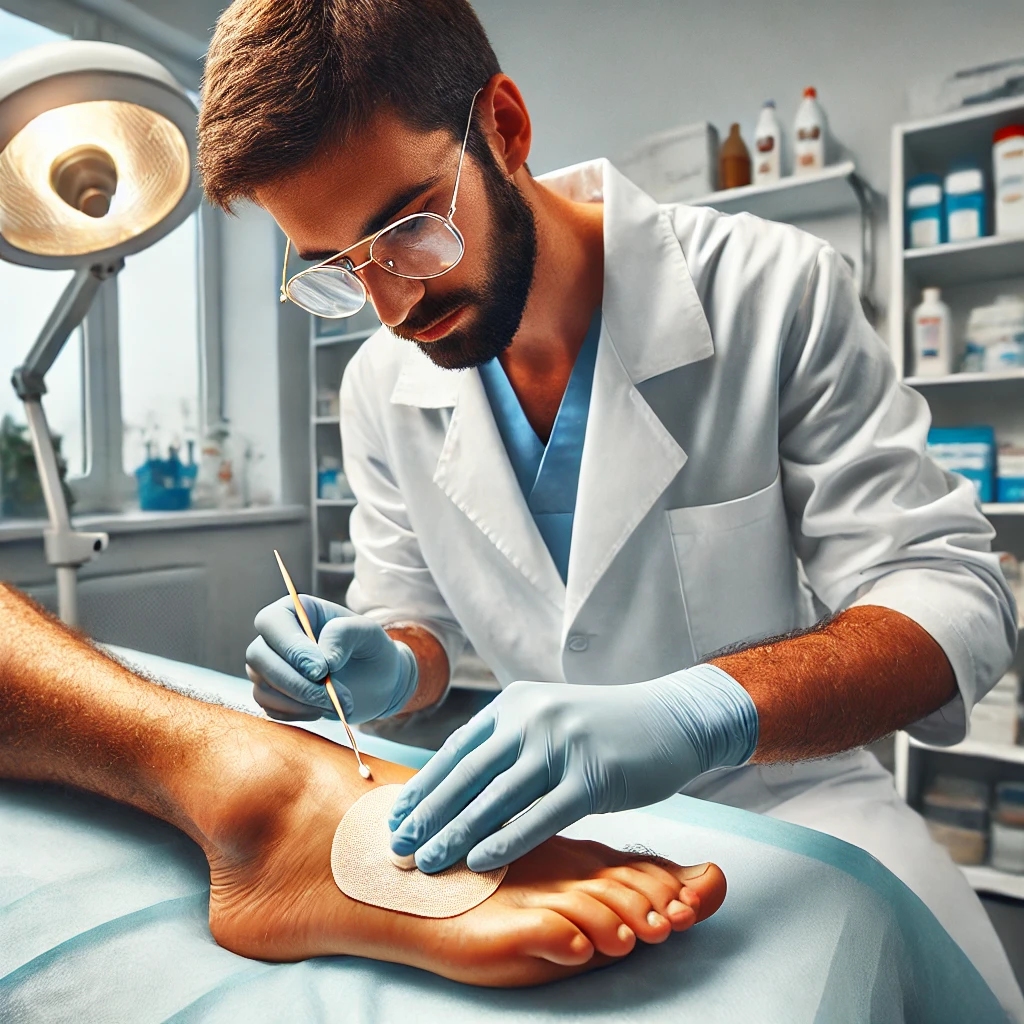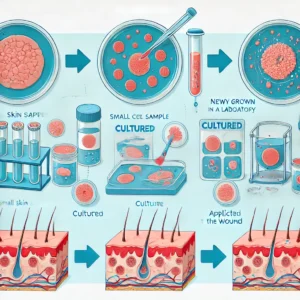
At WeTreatFeet Podiatry, we understand the challenges and worries that come with slow-healing wounds, especially on the feet and ankles. That’s why we’re committed to using the latest advancements in wound care, including innovative skin substitutes and cultured skin products. These technologies offer hope and healing for patients struggling with chronic wounds like diabetic foot ulcers, pressure sores, and surgical wounds that aren’t healing as expected. We’re here to help you understand these options and how they can benefit you.
What are Skin Substitutes and Cultured Skin?
Think of skin substitutes and cultured skin as “bandages” that go beyond simply covering a wound. They actively help your body heal itself. They provide a framework for your own cells to grow and repair the damaged tissue. Instead of simply covering the wound, Skin substitutes are like scaffolds that encourage your body to heal better.
- Skin Substitutes: These are biologically engineered products designed to mimic the properties of human skin. They can be made from various sources, including donated human skin (processed to remove cells and prevent rejection), animal tissues (collagen-based), or synthetic materials. They act as a temporary or permanent replacement for damaged or missing skin, providing a protective barrier and stimulating the healing process.
- Cultured Skin: This involves taking a small sample of your own healthy skin cells and growing them in a lab. The lab then creates sheets of new skin that can be grafted onto the wound. Because it’s your own skin, there’s no risk of rejection. This is particularly useful for large or complex wounds.

Image: A simplified diagram showing how cultured skin is created from a patient’s own cells and then applied to a wound.
Why are Skin Substitutes and Cultured Skin Used in Podiatry?
Podiatrists, especially at WeTreatFeet Podiatry, frequently treat wounds on the feet and ankles. These areas are often prone to slow healing due to poor circulation, pressure, and other factors. Skin substitutes and cultured skin offer several key advantages:
- Faster Healing: They provide a structure that encourages cell growth and tissue regeneration, leading to faster wound closure.
- Reduced Risk of Infection: The protective barrier helps prevent bacteria from entering the wound.
- Improved Pain Management: They can help reduce pain and discomfort associated with chronic wounds.
- Limb Salvage: In severe cases, particularly with diabetic foot ulcers, these advanced therapies can be crucial in preventing amputation and saving limbs.
- Better Cosmetic Outcomes: They can lead to a more natural-looking scar compared to traditional wound healing methods.
How WeTreatFeet Podiatrists Utilize Skin Substitutes and Cultured Skin
At WeTreatFeet Podiatry, our podiatrists are experts in wound care and have extensive experience using skin substitutes and cultured skin products. We follow a comprehensive approach to wound management, including:
- Thorough Evaluation: We carefully assess your wound, considering factors such as size, depth, location, blood flow, and underlying health conditions.
- Debridement: We remove any dead or infected tissue from the wound to create a clean and healthy base for healing.
- Selection of the Appropriate Product: We choose the most suitable skin substitute or cultured skin product based on your specific needs and the characteristics of your wound. This may include products like Apligraf, Dermagraft, or Integra. Learn More About Skin Substitute Products.
- Application and Monitoring: We carefully apply the chosen product and closely monitor your progress, making adjustments to your treatment plan as needed.
- Patient Education: We provide you with detailed instructions on how to care for your wound at home and answer any questions you may have.
Who Can Benefit from Skin Substitutes and Cultured Skin?
These advanced therapies may be beneficial for individuals with:
- Diabetic Foot Ulcers
- Venous Leg Ulcers
- Pressure Sores (Bedsores)
- Surgical Wounds that are Not Healing
- Traumatic Wounds
- Burns
Are Skin Substitutes and Cultured Skin Safe?
Yes, when used by experienced podiatrists like those at WeTreatFeet Podiatry, skin substitutes and cultured skin products are generally safe. The risks are minimal but can include infection or allergic reaction. We take every precaution to minimize these risks and ensure the best possible outcome for our patients.
The WeTreatFeet Podiatry Difference: Expertise in Wound Care & Limb Salvage
Choosing the right podiatrist for wound care is crucial. At WeTreatFeet Podiatry, we have a dedicated team of experienced podiatrists who are passionate about providing the highest quality care for our patients. We are committed to staying at the forefront of wound care advancements and utilizing the latest technologies to achieve the best possible outcomes. We believe that everyone deserves to have healthy, pain-free feet, and we are here to help you get back on your feet again.
Our expertise in using skin substitutes and cultured skin products has allowed us to save limbs and improve the lives of countless patients. We understand the physical and emotional toll that chronic wounds can take, and we are dedicated to providing compassionate and comprehensive care.
Contact WeTreatFeet Podiatry Today
If you are struggling with a slow-healing wound on your foot or ankle, don’t wait. Contact WeTreatFeet Podiatry today to schedule a consultation and learn more about how skin substitutes and cultured skin products can help you. Call us at [410-363-4343] or schedule an appointment online.
Learn more about: Peripheral Arterial Disease and Its Impact on Foot Health
Frequently Asked Questions (FAQ)
What is the recovery time after a skin substitute or cultured skin graft?
Recovery time varies depending on the size and location of the wound, as well as your overall health. We will provide you with detailed instructions on how to care for your wound and monitor your progress closely.
Is the procedure painful?
We use local anesthesia to minimize any discomfort during the procedure. Pain medication may be prescribed to manage any post-operative pain.
Will my insurance cover skin substitutes or cultured skin?
Many insurance plans cover these advanced therapies, but coverage can vary. Our team can help you navigate the insurance process and determine your coverage.

